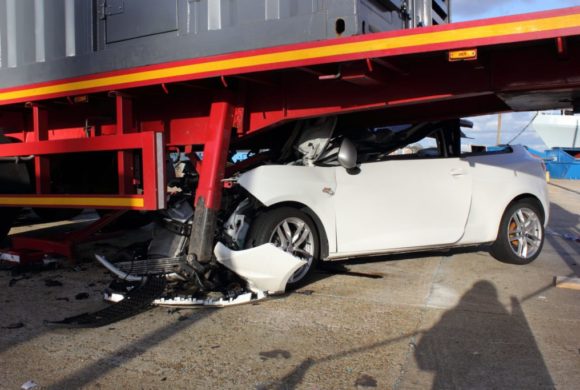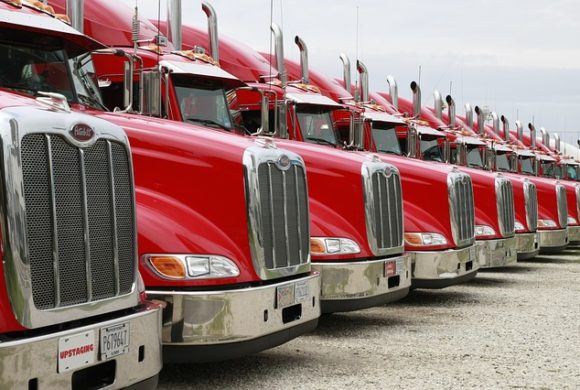
by Queener Law | Aug 21, 2017 | Colorado, Kentucky, Tennessee, Trucking Accident
A proposed rule that would have required truck drivers to submit to screenings for sleep apnea has been withdrawn by the Department of Transportation. The rule faced fierce opposition from truck drivers and some members of the trucking industry. The rule would have offered clarification to carriers and medical examiners concerning when truck drivers should be referred for sleep apnea testing. The Federal Motor Carrier Safety Administration published a notice on Aug. 4, 2017, announcing its withdrawal of the rule.
Rule Withdrawal
The FMCSA has been working on the sleep apnea rule protocol since 2016. It asked for input from the industry about when referrals should be made in its pre-rule notice. The Motor Carrier Safety Advisory Committee and the MRB recommended that truck drivers whose body mass indices exceeded 40 should be referred for sleep apnea testing. Truck drivers were overwhelmingly against the proposed rule because it would have required a large number of drivers to be tested because of age and weight requirements. The rule withdrawal also comes in an anti-regulatory environment under the current administration. Federal agencies have been asked to get rid of two regulations for every new one that is proposed.
Why the Sleep Apnea Rule Was Proposed
Untreated sleep apnea has been demonstrated to have a strong correlation with dangerous driving. In one study that was presented at the Sleep and Breathing Conference in Berlin on April 12, 2013, the researchers found that people who have sleep apnea are likelier to report falling asleep behind the wheel and to fail driving simulator tests. This study as well as others that demonstrate that drowsy and fatigued driving may be nearly as dangerous as drunk driving have long been a concern for safety experts. A truck accident lawyer sometimes handles injury cases involving truck drivers who fell asleep at the wheel.
What Is Sleep Apnea?
Sleep apnea is a disorder in which the muscles of the upper airway become so slack that the opening through which breathing occurs is cut off. This causes the sufferers to startle and wake slightly, and the pattern may repeat itself frequently throughout the night. Sleep apnea sufferers may thus get little quality sleep, making them drowsy during the daytime. A truck accident lawyer may investigate an accident to determine whether or not a driver had sleep apnea, causing the resulting injury accident. Doing so may help to prove the driver’s fault.

by Queener Law | Jul 11, 2017 | Colorado, Kentucky, Tennessee, Trucking Accident
Recent studies reveal that many of the serious, life changing and even deadly injuries every year caused by underride crashes can be minimized or prevented completely with the use of a new safety device. The product, known as AngelWing, is a side underride guard that is specifically designed to prevent passengers in smaller vehicles from suffering serious injuries or death in the event of a side collision with a large truck.
According to recent statistics, more than 200 victims are killed and even more are seriously injured by underride accidents in the United States every year. While federal law requires semi trucks to have rear underride guards in place, side guards are not currently required. And despite reports by the National Traffic Safety Board (NTSB) that conclude that side guards would reduce the risk of injury and death on America’s roadways, and their recommendation to the National Highway Traffic Safety Association (NTHSA) that all new truck trailers be equipped with side underride protection, the Truck Trailer Manufacturers Association continues to oppose such a requirement. The industry’s lobbying arm cites the additional costs, various technical challenges, and the concern that these side guards could add significant weight to a trailer or dangerously weaken its parts.
An Effective Solution for Semi Truck Underride Crashes
Approximately 62 percent of a large truck trailer’s length is protected when side underride guards are in place. Without these guards, only about 15 feet are protected. And while many semi trucks are currently equipped with composite side fairings, they are not designed to withstand the impact of a crash.
A recent study by the Insurance Institute of Highway Safety (IIHS) evaluated the effectiveness of AngelWing guards in 35 mph. side collisions versus side fairing skirts that were designed to enhance aerodynamics only. The results were dramatic, with the AngelWing guards preventing the smaller test vehicles from moving underneath the large truck, and the composite side fairings allowing the cars to slide under the trailer. When the car passed under the truck trailer, part of the roof of the smaller vehicle was sheared off and the car became wedged beneath the truck. If the simulations had included moving vehicles, those without AngelWing protection could have resulted in overturned trailers or the vehicle coming into contact with the rear axles. In real life, this type of crash would likely have caused severe, disabling injuries or fatalities.

by Queener Law | Jun 11, 2017 | Auto Accident, Colorado, Kentucky, Tennessee
Front-crash collision systems such as automatic brakes and collision warnings have been demonstrated to be highly effective in preventing rear-end accidents. The Insurance Institute for Highway Safety reviewed data to determine how effective these newer types of collision avoidance systems are and found that they greatly reduce the rates of rear-end crashes. An auto accident attorney represents victims of rear-end collisions to help them to recover damages when they have suffered injuries and financial harm.
How Effective Are Front Collision Systems?
Front collision warning systems have sensors to detect other vehicles or objects ahead of the vehicles in which they are installed and alert the drivers of their presence so that they can react in time. Automatic braking systems detect other vehicles and objects and automatically apply brakes to the vehicles to help them slow down in time to avoid collisions.
Early research about collision avoidance systems was conducted using information from insurance claims. While this data continues to be useful for studying crash avoidance technology, it has its limitations. To more accurately determine how effective these systems are in preventing accidents, the IIHS reviewed police reports from accidents and evaluated how front crash warning systems and automatic braking systems relate to the rate of rear-end collisions. The IIHS found that vehicles that are equipped with automatic braking systems had 39 percent fewer accidents. Those that had front-crash warning systems without automatic brakes were involved in 23 percent fewer collisions than vehicles that did not have these types of collision avoidance technologies.
What the Data Means
The IIHS states that if all vehicles had the front crash collision avoidance systems installed in 2013 during the study period, there would have been 700,000 fewer accidents and 300,000 fewer injuries. The efficacy of these systems has led the IIHS and the National Highway Traffic Safety Administration to recommend that they are offered as standard equipment on all new vehicles. Until the industry is required to offer these types of systems on their cars, people who are in the market for new vehicles can choose models that have the systems already installed or add them as options.
While safety technology will not prevent all accidents, its availability may help people to avoid them. Since motor vehicle collisions may result in significant injuries or deaths, taking steps to prevent them and implementing the use of advanced technology is important.

by Queener Law | Mar 14, 2017 | Colorado, Kentucky, Tennessee, Trucking Accident
The Federal Motor Carrier Safety Administration (FMCSA) requires regular safety inspections and maintenance for commercial trucks. Violations result in trucking accidents and personal injury claims that require truck accident attorneys.
Safety and Maintenance Regulations
The FMCSA requires all motor carriers to perform systematic inspections, maintenance, and repairs on commercial motor vehicles to ensure safe operations. For commercial vehicles, motor carriers must maintain inspection and repair records for each vehicle. Truck drivers are required to complete a written inspection report at the end of each driving day. The report must identify the vehicle and list any deficiencies or defects that may affect operational safety. The motor carrier must then certify that those deficiencies or defects are corrected.
Common Maintenance Safety Problems
Two of the most common safety issues that cause serious trucking accidents are faulty brakes and bad tires. In Tennessee, truck accident attorneys often see serious crashes and injuries caused by large trucks unable to stop in time to avoid accidents and sudden tire blowouts.
Faulty Brakes
According to the FMCSA, faulty brakes are responsible for at least five percent of all truck accidents. Due to the weight of large commercial trucks, standards for brake safety is highly regulated by the federal government. The responsibility for maintenance falls to the truck driver, who is required to inspect the vehicle each day, as well a maintenance specialist who can check for broken or missing parts and air leaks in the brake chamber. Vehicle manufacturers are also responsible for the safety of a truck’s braking system. If a truck’s brakes can’t decelerate it at a rate proportionate to the vehicle’s size, even when maintained properly, liability for the truck maintenance accident may lie with the manufacturer.
Bad Tires
Improper air pressure, worn treads, and mismatched tires contribute to serious trucking accidents seen by truck accident attorneys. The massive weight of commercial trucks — typically 10,000 to 50,000 pounds — requires properly inflated and maintained tires to ensure safe maneuverability and even weight distribution. Improper air pressure, worn treads, and mismatched tires can compromise the safety of the truck, resulting in tire blowouts and serious accidents. Truck drivers are responsible for inspecting their tires for air leaks, tread wear, and sidewall damages. Trucking companies are required to make sure that tires meet federal requirements for tread depth and ensure that drivers do not pair bias and radial tires on the same axle.

by Queener Law | Mar 6, 2017 | Colorado, Kentucky, Tennessee, Trucking Accident
Truck platooning might just bring significant changes to the transportation industry in the very near future. An innovative system that promises improvements in large truck safety, environmental friendliness and overall efficiency, the technology is quickly winning the support of trucking companies, truck drivers and safety advocates across the nation. Although there are still a number of hurdles that must be overcome before truck platooning hits the road on a regular basis, according to Steve Boyd, the co-founder of Peloton Technology which is the leader in developing this technology, Arkansas, Michigan, and Tennessee have all already given the go-ahead for platooning, and about eleven other states are currently considering approvals as well.
What is Large Truck Platooning?
This cutting-edge technology uses hundreds of sensors and highly advanced communications systems to create a semi-autonomous convoy of large trucks that are able to share important data and vehicle control. The innovative “road train” is led by a lead truck that controls the additional truck or trucks through wireless communication. During normal operation, the trucks drive very close together, and when the lead truck reacts to a traffic situation (activating its brakes for example) the following trucks automatically do the same. When traffic conditions demand so, the trucks can disengage to widen the gap between them to allow for things like merging traffic, and then link up again when the situation allows.
The belief that truck platooning is centered around driverless or completely autonomous vehicles is a common misconception. In fact, truck drivers are still very much involved in the operation of the platoon. The lead truck driver’s responsibilities are very similar to what they would be during normal truck operation, and the following drivers still have steering control and access to video monitoring that enables them to see what is going on from the perspective of the lead truck. According to Peloton the system “simply augments driver performance and safety and leverages the cooperative potential between pairs of trucks.”
The Numerous Benefits of Truck Platooning
There are a wide variety of benefits that come with large truck platooning. And since about 70 percent of freight in the United States is handled by the trucking industry, and large trucks make up approximately 4.3 percent of all highway vehicles, truck platooning can have a big impact.
Fuel Efficiency
When trucks are able to travel closer together, aerodynamic drag is significantly reduced which increases fuel efficiency. And the smaller the gap between trucks, the greater the savings. Some studies report that truck platooning can result in anywhere from 4 to 10 percent better fuel efficiency depending on a truck’s position in the platoon. Since about 65 percent of large truck miles are platoonable, fuel consumption in the United States could potentially be reduced by 1.5 billion gallons or more each year. Without common close following distance regulations across all 50 states, however, actual fuel savings will vary significantly from state to state.
Emissions Reduction
Large trucks are responsible for about 7.5 percent of total greenhouse gas (GHG) emissions in the United States. An analysis by researchers from the National Renewable Energy Laboratory (NREL) reveals that truck platooning could potentially result in a savings of about 15.3 million metric tons of carbon dioxide emissions every year.
Truck Driver Jobs
The shortage of truck drivers in the U.S. has gained a lot of focus in recent years. And while large truck platooning will by no means make the human driver obsolete, the technology could have a positive impact on truck driver shortages. A system that encompasses driver empowerment, truck platoons are expected to transform the truck driving occupation into a more attractive career choice for new drivers and seasoned operators alike. As automation progresses, drivers will be even more highly trained and skilled.
Safety
The Federal Motor Carrier Safety Administration (FMCSA) reports that there were approximately 87,000 large trucks involved in injury crashes in 2015 alone. Sadly, about 4,050 large trucks were involved in crashes that resulted in fatalities. Fortunately, platooning technology could bring significant improvements to highway safety. With automated emergency braking systems, dynamic geofencing, vehicle-to-vehicle (V2V) communications, and increased driver awareness, large trucks that are equipped with platooning technology will have enhanced performance and safety features that are almost certain to reduce the number of large truck accidents on America’s roadways.
When Might Motorists See Platooning Technology in Action?
Although autonomous vehicles are likely several years away from becoming commonplace on America’s roadways, truck platoons are a different story. It is expected that a commercial two-truck platooning system could be released for fleet operations in the later part of 2017, and in upcoming years the deployment of platoons is only expected to grow. Full-volume commercial deployments aren’t expected until 2018.

by Queener Law | Feb 17, 2017 | Colorado, Kentucky, Tennessee, Trucking Accident
Concussions are frequently seen by a truck accident attorney after trucking accidents, but determining liability requires documented medical evidence. Since post-concussion syndrome presents complex symptoms, diagnosis must be proven and the condition must be shown to be caused by the accident.
What is Post-Concussion Syndrome?
Typically, the onset of post-concussion syndrome occurs within a week or so of a brain injury and clears up in about three months, but in some cases, the patient’s symptoms can last for weeks, months, or even years after the concussion. Post-concussion syndrome symptoms are similar to those of a mild concussion, but they may also include complications such as dizziness, headaches, irritability, anxiety, fatigue, insomnia, memory loss, sensitivity to noise and light, and behavioral or emotional changes. Approximately 10 percent of people who suffer concussions in an accident handled by a truck accident attorney will suffer from post-concussion syndrome.
Post-concussion syndrome is one possible result of traumatic brain injury and unpredictable symptoms can significantly affect a person’s physical, mental and economic health. Since the symptoms and severity of post-concussion syndrome vary from person to person, there is no definitive course of treatment or timeline for recovery. Medical care often includes:
- Extended bed rest
- Medication
- Cognitive therapy to restore memory loss
- Vestibular therapy to restore balance
- Physical therapy to restore strength
- Psychotherapy
Determining Liability
Negligence or intentional harm determines liability in an auto or trucking accident. Negligence refers to the failure of a person or group of people to exercise a reasonable standard of care or precaution to prevent the accident. If a person is injured in a trucking accident caused by a negligent driver, that driver would be liable for injuries, including post-concussion syndrome caused by the accident. That driver would also be responsible for damages including medical expenses, lost wages and pain and suffering caused by the head trauma or brain injury.
When filing a personal injury claim for post-concussion syndrome, documented medical evidence is necessary to prove the case. A person can only claim damages for post-concussion syndrome as part of a personal injury case if his/her physician states in the medical records that it is caused by the accident. A potential problem with claiming damages for post-concussion syndrome is complex and vague symptoms, so some physicians may be hesitant to diagnose the condition. Because post-concussion syndrome presents complex symptoms, a truck accident attorney may be required to file a personal injury claim or lawsuit to recover damages.






